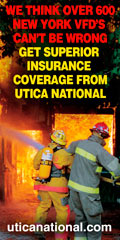
| Archives/Subscribe | Advertise | NYS Fire Chiefs | Size Up | July 2011 |
FCC Strengthens Enhanced 911 Location Accuracy Requirements for Wireless Services
On July 12, 2011, the Federal Communications Commission took action to enhance the public’s ability to contact emergency services during times of crisis and to enable public safety personnel to obtain more accurate information regarding the location of the caller. Specifically, the Commission strengthened the Enhanced 911 (E911) location accuracy rules for wireless carriers and sought comment on improving both 911 availability and E911 location determination for Voice over Internet Protocol (VoIP) services. E911 technology automatically provides a 911 call operator with the caller’s telephone number and location information from either a landline or a wireless phone. Wireless carriers have historically provided E911 location information by one of two methods: "handset-based," where location information is generated by GPS or similar technology installed in the caller’s handset, or "network-based," where location information is generated by triangulating the caller’s wireless signal in relation to nearby cell sites in the carrier’s network. The FCC’s rules require wireless carriers to identify the caller’s location for a specified percentage of 911 calls within a range of 50 to 150 meters for carriers that use handset-based technology, and 100 to 300 meters for carriers that use network-based technology. In September 2010, the Commission adopted benchmarks for wireless carriers to meet these handset- and network-based accuracy thresholds at the county or Public Safety Answering Point (PSAP) level for increasing percentages of 911 calls over an eight-year period. In July's action, the Commission announced that after the conclusion of the eight-year implementation period in early 2019, it will sunset the existing network-based rule and require all wireless carriers to meet the more stringent location accuracy standards in the handset-based rule. The Commission will set a specific sunset date for the network-based standard at a later date, after further notice and comment. The Commission also required new wireless network carriers to meet the handset-based accuracy standard going forward. The Commission also required all wireless carriers to test their E911 location accuracy results periodically and to share the results with PSAPs, state 911 offices, and the Commission, subject to confidentiality safeguards. The Commission referred to the Communications Security, Reliability, and Interoperability Council (CSRIC) the task of making recommendations to the Commission in six months on specific, cost effective testing requirements and methodologies. With respect to VoIP services, the Commission is seeking comment on whether it should apply existing 911 rules that cover two-way interconnected VoIP services to "outbound-only" interconnected VoIP services, which allow users to place outbound telephone calls but not to receive inbound telephone calls. The Commission is also asking for ways it might ensure that all interconnected VoIP providers can provide automatic location information for VoIP 911 calls, rather than relying on the subscriber to register his or her location with the VoIP provider. This includes considering mechanisms that would enable "over-the-top" interconnected VoIP service providers and underlying network access providers to jointly support the provision of location accuracy information to PSAPs. The Commission is also seeking input on ways that location technologies that are already being developed for commercial broadband applications might be leveraged to support 911 location determination. Finally, the Commission is soliciting comment on how to improve location accuracy for 911 calls made from indoors, including large office buildings where it may be difficult to locate an individual in trouble based only on a street address, and directed the CSRIC to develop recommendations for cost effective indoor location accuracy testing. Action by the Commission, July 12, 2011, by Third Report and Order, Second Further Notice of Proposed Rulemaking and Notice of Proposed Rulemaking (FCC 11-107). Chairman Genachowski and Commissioners Copps, McDowell, and Clyburn. Separate Statements issued by Chairman Genachowski and Commissioners Copps, McDowell, and Clyburn. GN Docket No. 11-117; PS Docket No. 07-114; WC Docket No. 05-196. Bureau contacts: David Furth, Deputy Bureau Chief, Public Safety and Homeland Security Bureau at (202) 418-0632 or david.furth@fcc.gov or Patrick Donovan at (202) 418-2413 or patrick.donovan@fcc.gov |
1670 Columbia Turnpike, P.O. Box 328
East Schodack, NY 12063-0328
Phone: (800) 676-FIRE or (518) 477-2631
Fax: (518) 477-4430
